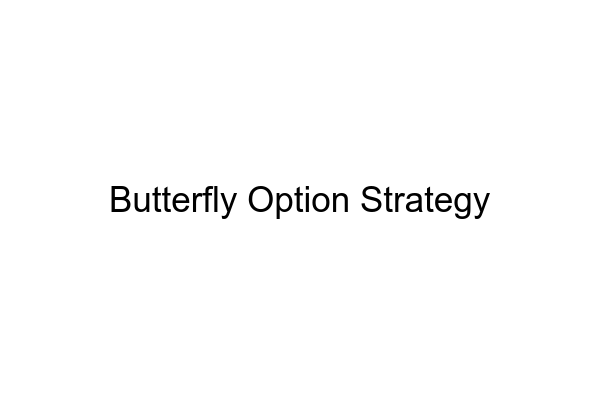Butterfly Option Strategy

What are the characteristics of this option strategy?
The butterfly option strategy is primarily a neutral strategy option used to simultaneously reduce risk and capitalize on low volatility markets. It’s composed of two puts and two calls on the same asset with the same expiration date, but with three different strike prices. It involves buying one lower strike price call, buying one higher strike price call, selling two at-the-money strikes, and potentially adding a protective put below the bought strikes.
Is this a bullish, bearish or neutral strategy?
The butterfly option strategy is a neutral strategy. It’s designed to take advantage of relatively low volatility and minimize risk, so it’s not suitable for taking directional bets on an asset.
Is this a beginner or an advanced option strategy?
The butterfly option strategy is considered to be an intermediate strategy, meaning it’s not too difficult to learn but still requires some knowledge of market and option behavior.
In what situation will I use this strategy?
This strategy is typically used when a trader expects the price of an underlying asset to stay relatively steady and not make a dramatic move. This is especially useful when implied volatility is low, as the strategy can capitalize on time decay and low option premiums.
Where does this strategy typically fall in the range of risk-reward and probability of profit?
This strategy generally has a smaller risk/reward and potential profit potential than other options strategies, but still has the potential to generate decent returns. Generally speaking, the strategy has higher probability of profitability than other strategies but lower maximum gains.
How is this strategy affected by the greeks?
The butterfly option strategy is most affected by gamma and vega, and moderately affected by theta and delta. Gamma measures the rate of change of an option’s delta, or the chance of the option expiring in-the-money. A large gamma suggests a large delta change and with it, a large probability of the option expiring in-the-money. Vega, meanwhile, shows the sensitivity of an option’s price to changes in volatility. The butterfly strategy is also moderately sensitive to theta, as it is designed to benefit from time decay of option prices, and delta, which measures the rate of change of an option’s price to changes in the asset’s price.
In what volatility regime (i.e VIX level) would this strategy be optimal?
This strategy is typically optimal when implied volatility is low and not expected to move significantly. The low volatility environment allows for the low-risk construction of the strategy and a lack of significant change in implied volatility keeps option premiums from skyrocketing and erasing returns.
How do I adjust this strategy when the trade goes against me? And how easy or difficult is this strategy to adjust?
Adjusting this strategy when the trade goes against you is relatively simple and straightforward. If the underlying asset moves against you, you can adjust the strike price of your long calls to keep your potential losses minimal. This is done by buying back the long calls and selling further out-of-the-money calls at the same or higher strike price to reduce your potential loss.
Where does this strategy typically fall in the range of commissions and fees?
Since the butterfly option strategy requires four separate transactions, commission and fees can be a factor when trading this strategy. Generally speaking, this strategy falls in the medium range of commissions and fees as it requires four transactions.
Is this a good option income strategy?
The butterfly option strategy generally is not considered to be a good option income strategy. This is primarily due to its relatively lower risk/reward ratio and smaller profit potential. However, it can still be used for generate some extra income in a low volatility, sideways moving market.
How do I know when to exit this strategy?
The best time to exit this strategy is when the underlying asset starts to make a significant move in either direction. This is indicative of a shift in the market and increased implied volatility, which cuts into the strategy’s potential returns.
How will market makers respond to this trade being opened?
Market makers will generally respond by charging a higher bid/ask spread or by paying lower premiums for options, since they will have to wait longer for the strategy to be profitable.
What is an example (with calculations) of this strategy?
An example of the butterfly option strategy is if you want to speculate on the price of stock ABC, which is currently trading at $50 per share. You could buy a 45 Call, sell two 50 Calls, and buy a 55 Call, all with the same expiration date. This would cost you $2 in total, minus commissions and fees. If the price of stock ABC stays between the 45 and 55 ranges, the strategy can produce a profit of $4 by the time the expiration date is reached.
MarketXLS is one of the leading stock options analysis tools available today that can help you evaluate and analyze the butterfly option strategy. It allows you to analyze the performance of different stocks and options strategies quickly and easily, giving you the insight you need to make the best trading decisions for your portfolio. MarketXLS is an invaluable asset for the modern investor, helping you make the smartest decisions possible.
Here are some templates that you can use to create your own models
Iron Butterfly Option Strategy
Long Butterfly with Calls Option Strategy
Long Butterfly with Puts Option Strategy
Butterfly for Shorts Spread
Reverse Iron Butterfly Spread
Short Butterfly Spread
Reverse Iron Albatross Spread
Search for all Templates here: https://marketxls.com/templates/
Relevant blogs that you can read to learn more about the topic
Making Sense of Option Time Value
Are Butterfly Spreads Right for You?
Maximizing Profits with a Bull Put Spread Strategy
Options Trading (Strategies)
Get RealTime Updated Option Prices
